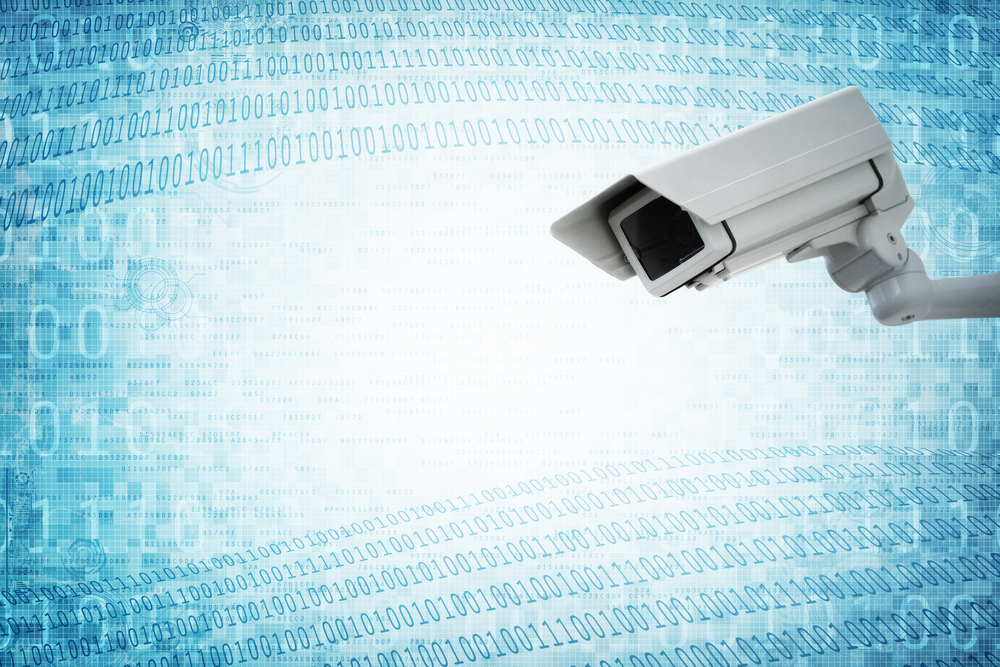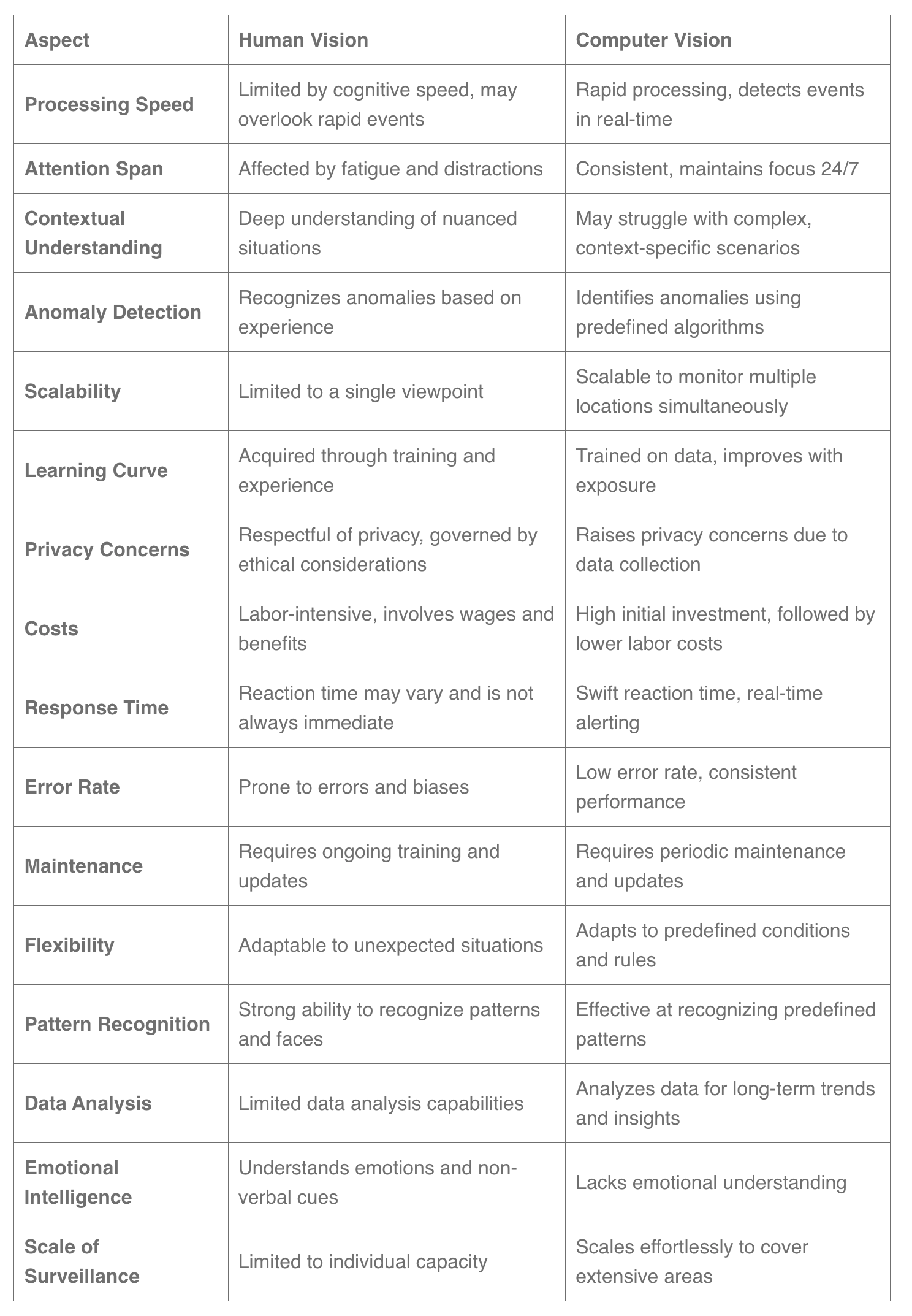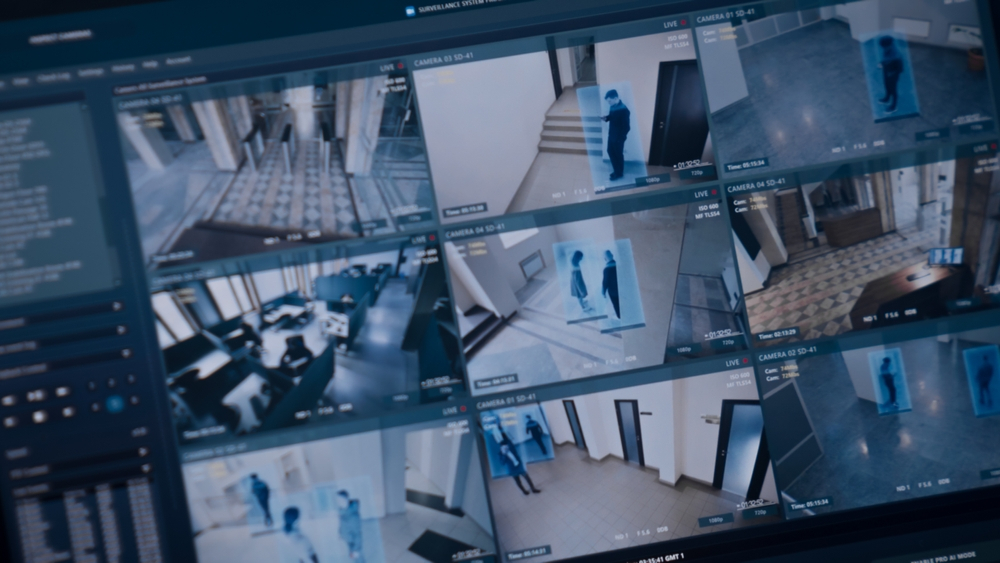Vision AI vs. Human Surveillance: Which Is Better for Workplace Safety?

See It In Action

Safety AI Software in Action
See how Visionify's Safety AI Software monitors workplace safety in real-time
Example Videos
Safety AI Software in Action
See how Visionify's Safety AI Software monitors workplace safety in real-time
Forklift Zone Monitoring with Vision AI
See how Vision AI monitors forklift zones in real-time to prevent accidents
Hard Hat Compliance in Manufacturing
Vision AI PPE Compliance for Manufacturing
Key Takeaways
- Complementary Strengths: Vision AI and human surveillance each bring unique capabilities to workplace safety
- Continuous Monitoring: Vision AI provides 24/7 vigilance without fatigue or attention lapses
- Contextual Understanding: Humans excel at interpreting complex situations and applying experience
- Cost Considerations: Vision AI requires higher initial investment but lower long-term operational costs
- Hybrid Approach: Many organizations benefit from combining both methods for comprehensive safety coverage
The Evolution of Workplace Safety Monitoring
Workplace safety monitoring has undergone a significant transformation in recent years. Traditional approaches have relied heavily on human observers—safety officers patrolling facilities, monitoring CCTV feeds, and conducting periodic inspections. While effective in many scenarios, these methods have inherent limitations in consistency, coverage, and scalability.
The emergence of Vision AI—artificial intelligence systems that can "see" and interpret visual information—has introduced new possibilities for safety monitoring. These systems use advanced algorithms to analyze video feeds from cameras positioned throughout work environments, identifying potential safety hazards and compliance issues in real-time.
 Vision AI systems can monitor multiple areas simultaneously with consistent performance
Vision AI systems can monitor multiple areas simultaneously with consistent performance
Human Surveillance: Strengths and Limitations
Strengths of Human Surveillance
Human safety monitors bring several irreplaceable strengths to workplace safety:
Contextual Understanding: Humans excel at interpreting complex situations, applying their experience and judgment to understand nuanced safety scenarios that might confuse AI systems.
Adaptability: Human monitors can quickly adapt to unexpected situations, adjusting their approach based on changing circumstances without requiring reprogramming.
Relationship Building: The presence of safety personnel helps build a culture of safety through personal interactions, coaching, and immediate feedback.
Critical Thinking: Humans can solve novel problems by applying creative thinking and drawing connections between seemingly unrelated factors.
Limitations of Human Surveillance
Despite these strengths, human surveillance faces significant challenges:
Fatigue and Attention: Human attention inevitably wavers during long monitoring periods, creating windows of vulnerability when hazards might be missed.
Coverage Constraints: A single person can only monitor a limited area, making comprehensive coverage of large facilities challenging and expensive.
Consistency Issues: Different observers may interpret the same situation differently, leading to inconsistent enforcement of safety standards.
Cost Factors: Human surveillance requires significant ongoing investment in wages, benefits, training, and management.
Vision AI: Transforming Safety Monitoring
Advantages of Vision AI
Vision AI systems offer compelling advantages for workplace safety monitoring:
Continuous Vigilance: Unlike humans, AI systems can monitor environments 24/7 without fatigue, maintaining consistent performance regardless of time or conditions.
Simultaneous Monitoring: A single Vision AI system can monitor multiple locations simultaneously, providing comprehensive coverage without proportional increases in cost.
Real-Time Detection: Advanced algorithms can identify safety hazards as they develop, triggering immediate alerts that enable rapid response before incidents escalate.
Objective Assessment: AI systems apply the same standards consistently across all monitoring, eliminating the subjective variations that can occur with human observers.
Data Collection: Vision AI continuously gathers data that can be analyzed to identify safety trends, recurring issues, and opportunities for proactive improvements.
Limitations of Vision AI
Despite these advantages, Vision AI has its own limitations:
Contextual Understanding: AI systems may struggle to interpret complex or novel situations that fall outside their training parameters.
Initial Investment: Implementing Vision AI requires significant upfront investment in hardware, software, and integration.
Technical Limitations: Environmental factors like lighting, weather, or unusual circumstances can sometimes challenge AI systems' accuracy.
Privacy Considerations: The deployment of AI surveillance raises important questions about worker privacy and data security that must be carefully addressed.
 Comparison of key attributes between human and AI-based safety monitoring
Comparison of key attributes between human and AI-based safety monitoring
Finding the Right Balance: The Hybrid Approach
Rather than viewing Vision AI and human surveillance as competing alternatives, many organizations are discovering the benefits of a hybrid approach that leverages the strengths of both methods.
In this model, Vision AI handles continuous monitoring across multiple areas, flagging potential issues for human review. Safety professionals can then focus their attention on addressing specific concerns, analyzing trends identified by the AI, and developing improved safety protocols based on comprehensive data.
This combination maximizes the strengths of both approaches while minimizing their respective limitations:
- Vision AI provides the consistent, comprehensive monitoring that humans cannot maintain
- Human experts provide the contextual understanding and critical thinking that AI currently lacks
- Together, they create a more robust safety system than either could achieve independently
Implementation Considerations
Organizations considering Vision AI for safety monitoring should consider several factors:
 Vision AI implementation considerations
Vision AI implementation considerations
Integration with Existing Systems: How will Vision AI complement current safety protocols and technologies?
Privacy Policies: Clear policies regarding data collection, storage, and usage are essential for addressing privacy concerns.
Staff Training: Safety personnel will need training to effectively work with AI systems, interpreting alerts and responding appropriately.
Phased Implementation: Starting with high-risk areas allows organizations to refine their approach before full-scale deployment.
Conclusion: The Future of Workplace Safety Monitoring
The question isn't whether Vision AI or human surveillance is better for workplace safety—it's how to effectively combine these approaches to create safer work environments. As Vision AI technology continues to advance, the balance between automated and human monitoring will evolve, but the need for both is likely to remain.
Organizations that thoughtfully integrate these complementary approaches can achieve a level of safety monitoring that neither method could provide alone—continuous, comprehensive, and contextually aware. This hybrid model represents not just the current best practice but the future direction of workplace safety monitoring.
Ready to explore how Vision AI can enhance your workplace safety monitoring? Contact Visionify today to learn how our solutions can complement your existing safety programs.
Frequently Asked Questions
Find answers to common questions about this topic
Want to learn more?
Discover how our Vision AI safety solutions can transform your workplace safety.
Schedule a DemoSchedule a Meeting
Book a personalized demo with our product specialists to see how our AI safety solutions can work for your business.
Choose a convenient time
Select from available slots in your timezone
30-minute consultation
Brief but comprehensive overview of our solutions
Meet our product experts
Get answers to your specific questions
Table of Contents
Related Articles
Subscribe to our newsletter
Get the latest safety insights and updates delivered to your inbox.


